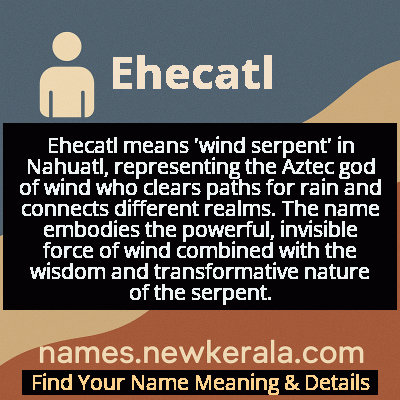Ehecatl Name Meaning & Details
Origin, Popularity, Numerology Analysis & Name Meaning of Ehecatl
Discover the origin, meaning, and cultural significance of the name EHECATL. Delve into its historical roots and explore the lasting impact it has had on communities and traditions.
Name
Ehecatl
Gender
Male
Origin
Nahuatl
Lucky Number
9
Meaning of the Name - Ehecatl
Ehecatl means 'wind serpent' in Nahuatl, representing the Aztec god of wind who clears paths for rain and connects different realms. The name embodies the powerful, invisible force of wind combined with the wisdom and transformative nature of the serpent.
Ehecatl - Complete Numerology Analysis
Your Numerology Number
Based on Pythagorean Numerology System
Ruling Planet
Mars
Positive Nature
Generous, passionate, energetic, and humanitarian.
Negative Traits
Impulsive, impatient, moody, and can be overly emotional.
Lucky Colours
Red, maroon, scarlet.
Lucky Days
Tuesday.
Lucky Stones
Red coral, garnet.
Harmony Numbers
1, 2, 3, 6.
Best Suited Professions
Military, sports, philanthropy, leadership roles.
What People Like About You
Courage, energy, leadership, generosity.
Famous People Named Ehecatl
Ehecatl Quetzalcoatl
Mesoamerican deity
Wind aspect of the feathered serpent god Quetzalcoatl in Aztec mythology
Ehecatl Tonatiuh
Mesoamerican deity
Solar wind deity representing the movement of the sun across the sky
Ehecatl Perez
Contemporary artist
Modern Nahuatl artist reviving traditional Mesoamerican art forms
Name Variations & International Equivalents
Click on blue names to explore their detailed meanings. Gray names with will be available soon.
Cultural & Historical Significance
Ehecatl temples were uniquely circular in design, allowing wind to flow freely around them, demonstrating the architectural integration of spiritual beliefs. This deity was also closely associated with Quetzalcoatl, sometimes considered his wind aspect, emphasizing the interconnectedness of natural elements in Nahuatl cosmology. The worship of Ehecatl reflected the deep understanding ancient Mesoamericans had of natural cycles and their reverence for the elements that sustained life. His role in creation myths and daily rituals shows how wind was perceived not just as a physical phenomenon but as a sacred, animating force in the universe.
Extended Personality Analysis
Individuals named Ehecatl are often perceived as free-spirited, dynamic, and intellectually curious. Like the wind they're named after, they tend to be adaptable and constantly moving, both physically and mentally. They possess a natural ability to communicate and connect people, much like the wind that carries messages across distances. Their personality often combines the serpent's wisdom with the wind's freedom—strategic yet spontaneous, grounded yet ethereal. They typically exhibit strong leadership qualities with a gentle touch, preferring to influence through inspiration rather than force.
The wind serpent symbolism suggests someone who can navigate complex situations with grace and who brings fresh perspectives to stagnant environments. They're often creative problem-solvers who can see connections others miss, and they value both tradition and innovation in equal measure. While they may appear restless or unpredictable to some, this stems from their deep need for growth and exploration. Their strength lies in their ability to adapt while maintaining core values, much like the wind that changes direction yet remains fundamentally constant in its nature. They often become catalysts for change in their communities, using their influence to create movement and progress.
Modern Usage & Popularity
In contemporary times, Ehecatl remains primarily used within indigenous Nahua communities and among people of Mesoamerican heritage seeking to preserve cultural traditions. The name has seen a modest resurgence as part of the broader indigenous rights movement and cultural revitalization efforts. While still uncommon in mainstream contexts, it appears occasionally in artistic and academic circles, particularly among those studying or celebrating pre-Columbian cultures. Some parents choose this name to honor their ancestral heritage or to connect their children with indigenous wisdom traditions. The name maintains its strongest presence in Mexico and among diaspora communities, with usage patterns reflecting both cultural preservation and selective adoption by non-indigenous people interested in Mesoamerican spirituality.
Symbolic & Spiritual Meanings
Ehecatl symbolizes the invisible forces that shape our world—the breath of life, the movement of change, and the connection between different realms of existence. As a wind serpent, it represents the marriage of earthly wisdom (serpent) with celestial freedom (wind). The wind aspect signifies communication, movement, and the life-giving force of air, while the serpent represents transformation, healing, and ancestral knowledge. Together, they create a powerful symbol of balanced power—strong yet gentle, ancient yet ever-renewing. Ehecatl embodies the concept that true strength lies not in domination but in harmonious influence, much like the wind that shapes landscapes over time without force. This dual nature makes it a symbol of adaptive intelligence and spiritual evolution, representing the ability to navigate both physical and metaphysical realms with equal grace.

